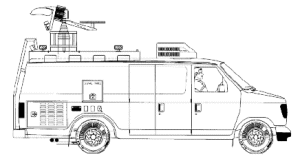E.N.G. Vehicle Safety: Fatality Alert
This information is directed to all users of Electronic News Gathering (E.N.G.) Vehicles.
An experienced television E.N.G. Microvan Operator was recently electrocuted when he raised the mast on his vehicle into overhead power lines.
Without adequate training and procedures in place, vehicles equipped with telescopic masts working in proximity to high voltage power lines will endanger workers. Similar accidents in this industry have demonstrated that:
It is not safe to set-up E.N.G. vehicles:
- Under power lines or at a curb adjacent to utility poles carrying power lines.
- Where the nature of overhead lines is unknown, assume they are power lines.
- Be aware that power lines cross streets. Just because the power poles are not on your side of the street doesn't mean that your side is clear.
- On uneven ground where the vehicle is not reasonably level.
- Where the mast will not be completely visible as it is being extended.
Vehicles are not to be set up or operated beneath power lines.
Before raising the mast, make sure that it is:
-
Clear of any potential obstacles that could interfere with full extension, including overhead wires, tree branches, etc. To verify this, the operator should walk completely around the truck and look up from all angles.
- Wires may be hidden from view at one location but visible from another - obstructions such as tree branches can hide power lines from view.
- All portions of the mast and antenna must be kept a safe distance from live electrical parts in any direction:
Minimum Safe Clearance from Live Electrical Equipment (as per section 8.5(6) of the Canada Occupational Health and Safety Regulations) Voltage Range: Distance in Metres Between 425 and 50,000 3.0 Between 50,000 and 120,000 4.5 Between 120,000 and 250,000 6.0 Between 250,000 and 350,000 7.5 Between 350,000 and 400,000 9.0 -
Completely visible.
- When operating in overcast, dark shadow and/or twilight conditions, the operator must verify that the mast flood light is operating before beginning to extend the mast.

Basic Layout of an Electronic News Gathering Van
The Canada Labour Code, Part II and the Canada Occupational Health and Safety Regulations prescribe the requirements of both employers and employees with respect to safety.
Employer Requirements Include (But are not limited to):
- Advising employees of the potential risks of power line contacts.
- Training employees to ensure that the minimum clearances prescribed in the Regulations are maintained from power lines.
- Establishing written work procedures for the safe and proper performance of the job(s).
- Ensuring that all equipment is used safely, properly and in accordance with any instructions provided by the manufacturer at all times.
Employee Requirements Include (But are not limited to):
- Ensuring that their bodies and any tools or equipment they handle be kept more than the minimum clearance from power lines as prescribed in the Regulations.
- Following safe work procedures established by the employer.
- Reporting to the employer any thing or circumstance likely to be hazardous while carrying out their work.
Learn What Must Be Done to Stay Alive:
"Always Look Up and Live!"
For further information, contact:
Human Resources and Skills Development Canada - Labour Program
(see the blue pages of your phone book for the office located nearest you)
Portions of this hazard alert were taken from material created and placed on the Internet by Andrew Funk (while he was Assistant News Operations Manager at FOX-5 in Atlanta, Georgia). Visit Mr. Funk's website to see his work in it's entirety.